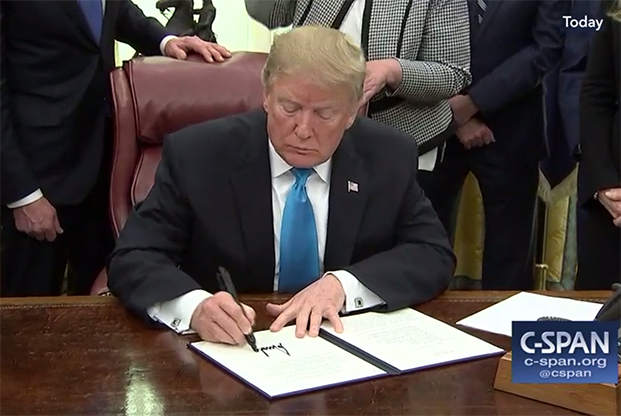
President Donald Trump signs "Space Policy Directive 4" in the Oval Office at the White House on Feb. 19, 2019. C-SPAN screenshot.
President Trump on Tuesday formally instructed the Pentagon to plan for a Space Force as a sixth military branch within the Department of the Air Force, a precursor to a possible separate service in the future.
Signing “Space Policy Directive-4” at the White House this week puts the onus on Congress to decide whether to approve the Defense Department’s forthcoming legislative proposal—potentially as part of the fiscal 2020 defense policy bill.
“They want this legislative proposal up to the Hill as soon as we possibly can,” a senior administration official said during a background briefing call Tuesday. “They do have a very compressed and crammed calendar. We’re sympathetic with that. … We think we’ve constructed it in such a way that the priorities are clear and that we’re flexible on it. And I think there is a lot of commonality on both sides of the aisle.”
The Space Force would be led by the Air Force Secretary, though it will have its own Chief of Staff, similar to the US Marine Corps, which is led by the Navy Secretary. It would be in charge of organizing, training, and equipping space personnel. The military-run combatant command, US Space Command, is slated to stand up in 2019 and will oversee joint space operations. The two are intended to support each other in defending against foreign militaries’ advancing space capabilities, not duplicate effort, a senior administration official said on the call.
“Rather than rush into a bureaucratic reconstruction, focus and investment should be directed at reinvigorating the newly created US Space Command. We need to invest in national defense, not national bureaucracy,” AFA Chairman of the Board and former Air Force Secretary Whit Peters said.
A Space Force should bring existing military space personnel and authorities under one roof, including “uniformed and civilian personnel conducting and directly supporting space operations,” according to the text of the directive. It would also oversee all related major acquisition programs, and offer a framework for specialized careers in space operations, intelligence, engineering, science, acquisition, and cybersecurity.
“If enacted, it will be our responsibility to deter and defeat threats in space through the US Space Force,” an Air Force spokesman said in an email. “It will be our obligation to ensure unfettered access to, and freedom to operate in space, and to provide vital capabilities to joint and coalition forces.”
Speaking at the Brookings Institution on Tuesday, Air Force Chief of Staff Gen. David Goldfein compared the creation of a Space Force under the Air Force as analogous to the Marine Corps under the Navy, and said a combatant commander for space is urgently needed.
“Eighty to 90 percent” of the Space Force will be comprised of airmen, Goldfein asserted. There are “a thousand decisions to be made” before the next step in establishing the Space Force, he said, and structures from a fully separate service “down to the JAG” (Judge Advocate General) and medical corps were evaluated in the process.
The Defense Secretary and national intelligence director must now draft plans for closer collaboration between the defense and intelligence communities, and report to the President within the next 180 days. Another 90-day review will look at ways to push operational authorities to lower management levels so warfighters can respond to threats faster.
“That doesn’t mean everything goes, but it does mean that we want to put more responsibilities down with satellite operators and squadron commanders in the field who can take actions and not have to wait for Washington if there’s an imminent threat,” an official said.
Air Force Secretary Heather Wilson previously estimated standing up a new force as a separate department as well as a new combatant command dedicated to space would cost $13 billion over five years. Todd Harrison, a defense budget analyst at the Center for Strategic and International Studies, argues that building a new service—not including US Space Command—would cost the Pentagon $1.5 billion to $2.7 billion over five years.
On the background call, an official said they anticipate the cost to stand up Space Force will be in the “low, single-digit billions,” in line with previous estimates by acting Defense Secretary Patrick Shanahan.
“It certainly won’t grow to in excess of $10 billion over time, but it will certainly—as our estimates and understanding of standing up a new service … mature—that will evolve over time,” an official said. “We’ll work closely with the Congress to answer their detailed questions about what those talks involve.”
Funding to come in the fiscal 2020 budget request will be split into three bins, an official said:
- One pot to pay for existing assets and operations that would be transferred to the new organizations.
- A second pot to grow system resiliency and invest in capabilities that counter space threats.
- A third for the Space Force itself that could include under $100 million for a headquarters.
But the White House isn’t backing down from its eventual goal to establish an independent department for space, and it sees the Space Force as a first step in that direction. As part of this week’s directive, the Defense Secretary must periodically consider when might be the right time to break out the Space Force as its own department.
“I don’t think that anyone believes that this is going to be one and done in one move,” an official said. “This is something we’re going to have to [gain] experience with over time.”?